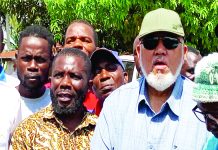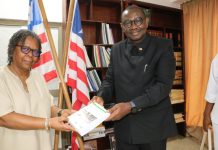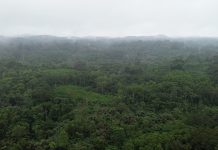Top: Bloh Sayeah wrongly likened USAID’s US$10 million Land Management Activity to an ill-fated loan Firestone awarded Liberia in the 1920s. The DayLight/James Harding Giahyue
By James Harding Giahyue
Bloh Sayeh, a commissioner at the Liberia Land Authority, might have impressed delegates of the just-ended National Land Conference with a piece of a history lesson on the United States of America’s contribution to Liberia’s nation-building process. Just that she got it wrong by comparing a US$10 million USAID—which was launched at the conference—to the controversial Firestone Loan of 1927.
Sayeh recounted the United States’ contribution to Liberia, citing the Quakers, whose advocacy led to the abolition of slavery, subsequently, the formation of the Liberian nation in 1822. However, she incorrectly added the loan to her list.
Fact-check
The former director of the Center for National Documents and Records Agency was wrong in two ways: First, the United States Agency for International Development is an entity of the U.S. government, while Firestone is a private firm. So, a loan from Firestone should not be listed as goodwill from the people of America. Second, and most importantly, the loan proved counterproductive to Liberia and tested U.S.-Liberia relations those days.
To understand The DayLight’s fact-checking of her comments, we need to dig a little more into history.
As a part of the agreement between Liberia and Firestone, the Liberian government was given funding to pay the foreign debts it had incurred and to develop a harbor necessary for rubber exportation. In return for a US$5 million loan at a seven percent interest rate, Firestone was given complete authority over Liberian revenues until it was repaid. Over time the loan took a larger and larger portion of government income: it grew from 20 percent of the total revenue of Liberia in 1929, to 32 percent in 1930, to 54.9 percent in 1931, and nearly the whole revenue in 1932. A member of the American Legation in Liberia estimated that Liberia effectively paid a 17 percent interest rate on the loan.
The loan had always been controversial, owned to the infamous clause “K,” in the last stages of the negotiation. It was the same as the US$8 million loan deal the Daniel E. Howard administration had obtained from the US government but was disapproved by Congress. Clause K had sparked protest in and outside the country. It was only accepted after both parties saw the deal as necessary for their political economies.
At the end of World War I, Great Britain—the leader of the global trade of rubber—decided to restrict the supply of the commodity on the world market. So, Firestone decided to come to Liberia to nullify Great Britain’s dominance of the global rubber market. Liberia’s humid climate was an ideal area for growing rubber. It also found that Liberia had a cheap labor force, and the government too was eager to offer a concession in exchange for U.S. protection against colonial neighbors who were impatient to annex the country, a nation it helped establish in 1822. Moreover, Firestone wanted political control in Liberia to protect its long-term investment. Liberia owed more than US$1 million to British bankers. That was a safeguard to avoid the British direct meddling into Liberia’s internal affairs. Also, Firestone’s action was a strategic decision aimed at protecting its rubber production deal with the Liberian government. Similarly, the U.S. government got interested and supported Firestone’s plans which included a promise to construct a major port. Firestone did not need a port to export the rubber from Liberia but merely proposed it to get the approval and support of the US State Department, which was particularly interested in a port on the West African coast for naval use.
As the price of rubber fell during the Great Depression, Firestone stopped its development of the plantation, using just 50,000 acres and cutting wages in half. Depriving the Liberian government of tax incomes, Liberia missed a loan payment to the company. Firestone asked the U.S. government to send a warship to Monrovia to enforce the debt payment, but President Franklin Delano Roosevelt disallowed the “gunboat diplomacy,” writing in a memorandum to the State Department that, “At all times we should remember that (Harvey) Firestone went to Liberia at his own financial risk, and it is not the business of the State Department to pull his financial chestnut out of the fire except as a friend of the Liberian people.”
In 1932, the Liberian Legislature passed the Moratorium Act, suspending payment of the Firestone loan until terms could be negotiated that were more in line with Liberia’s ability to pay. The U.S. suspended diplomatic relations but did not take further action. To date, there’s no record to show that the government paid back Firestone this money.
Citations: https://www.foreignaffairs.com/articles/liberia/1933-07-01/liberia-league-and-united-states
https://en.wikipedia.org/wiki/Firestone_Natural_Rubber_Company#cite_note-dubois-2
https://en.wikipedia.org/wiki/Great_Depression
https://en.wikipedia.org/wiki/Franklin_Delano_Roosevelt
Rich Land, Poor Country – The Paradox of Poverty in Liberia
https://www.tandfonline.com/doi/abs/10.1080/00083968.1967.10803470





Facebook Comments